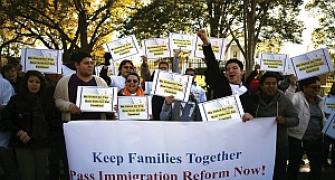 Experts doubt if United States President Barack Obama's health-care law, that is to come into effect in 2014, can be translated into reality without matching immigration reform.
Experts doubt if United States President Barack Obama's health-care law, that is to come into effect in 2014, can be translated into reality without matching immigration reform.
Without immigration reform, they point out; there will not be enough physicians and other care professionals to take care of the 30 million hitherto uninsured people estimated to come into the health-care fold. Compounding the problem is the aging population of the baby-boomer generation.
There are over 100 million Americans age 50 or older, and approximately 3.5 million baby boomers turn 55 every year. In another 20 years, over 20 percent of America's population is expected to be 65 or older, according to United Nations estimates.
The projected shortfall of physicians, even without taking into account the aging population, is of more than 65,000 doctors. How can 'Obamacare' take care of those needing care, then?
"There is no other way," said Dr Narendra Kumar, president, American Association of Physicians of Indian Origin, "except a major reform in our immigration system, especially in relation to J-1 visas that allow international medical graduates to come to the United States."
"I think we will need to support the idea of changing the immigration laws to cope up with the situation -- about which we have been advocating for a long time.
"We need to facilitate the entry of IMGs and utilise their services. We have so many talented and well-educated physicians not only trying to come from India, but also here in the US who go to Caribbean island medical schools. And although they are US citizens, they are still considered as IMGs."
"So, there is no dearth of medical doctors, but the immigration systems needs to be changed to allow IMGs to enter this country and those who are here to be recognised as licensed doctors without much hassle or obstacles."
A report published by the National Foundation for American Policy last week pointed out that the US immigration process sets up significant obstacles for foreign-born doctors. Because to be granted a license to work as a physician in the US, a foreign national must complete a graduate medical education, which usually means entering on a J-1 or an H-1B visa.
But a J-1 visa requires an individual to return to his or her home country unless a waiver is received. J-1 waivers often require a foreign doctor to work in an underserved area in the US.
Such waivers can be issued through a government agency and/or via the Conrad 30 program. Under the law, Conrad program J-1 waivers are limited to 30 per state, which means that in large states the waivers can be exhausted in days.
Puneet Arora, medical director at Genentech, who had to wait for more than seven years for his Green Card even after his residency in the US, agreed with the NFAP's findings.
He said the national interest waiver, an act of the Clinton era, does not work thanks to its interpretation by the immigration authorities.
"The national interest waiver, which means that anybody could file for a waiver, if he or she has served in the US for five years, did not work for me," Arora, an endocrinologist, engaged in medical research, told India Abroad.
"In my case the immigration denied me because they said that this is for Primary Care Physicians and not for specialists although the law says that it is for any doctor."
"In today's economy, we need people from certain countries like India and China, but they are pushed behind because of the cap on Green Cards."
"There is an urgent need for comprehensive reform of immigration law, specifically relating to the physicians' entry issue. That needs to be dealt separately at least for the next decade or so."
The NFAP report noted, "At a time of tremendous need in health care, the US is saddled with an immigration system designed to prevent, not facilitate, the entry of highly skilled physicians, nurses, physical therapists and other foreign-born medical personnel."
The report, titled 'The US Government, Heal Thyself: Immigration Restrictions and America's Growing Health Care Needs', made four broad recommendations. These include expanding the number of employment-based Green Cards so the wait times for skilled immigrants -- including nurses, physicians, and physical/occupational therapists -- can be measured in weeks or months, rather than in years or decades; and establishing a temporary visa that facilitates the entry of foreign nurses.
It also recommended that to aid patients in underserved areas and to enable more US-trained doctors to pursue specialised medical fields, the administration needs to expand the Conrad 30 (Dakota Senator) program to include many more physicians per state and in the country as a whole.
"Also," said Stuart Anderson, the main author of the report and executive director, NFAP, "We should consider policies to overcome the limitations on medical residency slots in the US by developing guidelines to allow foreign-trained doctors to practice in the US if they can demonstrate a high level of expertise."
"The Congress logically should include physicians and medical researchers in biology and chemistry in the definition of Science Technology Engineering and Mathematics for exemption from employment-based Green Card quotas in future legislation," he said.
India sends the largest number of IMGs to the US, according to AAPI's estimate.
"Over 1,500 doctors come to the US every tear but the numbers could be double if the immigration rule is eased," Kumar said.
Ted Epperly of the American Academy of Family Physicians was quoted in the NFAP report as saying that finding a doctor in America will get increasingly difficult, waits for appointments will grow longer, and more sick people will turn to crowded emergency rooms.
The Association of American Medical Colleges estimates that in 2015 the country will have 62,900 fewer doctors than needed, according to a New York Times report.
"And that number will more than double by 2025, as the expansion of insurance coverage and the aging of baby boomers drive up demand for care."
Siskind Greg, a Tennessee-based immigration attorney who has worked with Dakota Senator Kent Conrad, told India Abroad. "There are a lot of good things in that bill (Senate bill 1979), which would be a good start at addressing some of the issues you're talking about."
Greg was optimistic. He said, "There seems to be already, on the employment-based immigration side, a lot of agreement from both parties that there need to be changes. They've been closer on a lot of these things, particularly on the advanced degree professionals. There's a negotiation going on right now between both Houses on a bill."
"So I would say I'm pretty optimistic that physicians, as well as other highly skilled workers, are going to be dealt with, probably in 2013. If not by themselves, it'll be part of the big immigration bill."
Picture: President Barack Obama after a news conference in the East Room of the White House, November 14, in which he said comprehensive immigration reform would be a priority in his second term
Photographer: Chip Somodevilla/Getty Images







